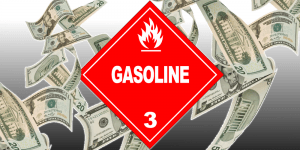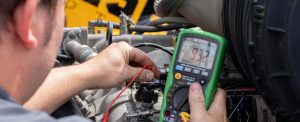Data analytics help fleets lower costs
by Al Barner

Fuel prices have overtaken driver shortage as the top concern expressed by drivers and motor carriers as reported by ATRI 2022 Top Industry Issues survey.
Today’s fuel prices have re-introduced a bevy of asset management challenges for fleets that significantly impact the bottom line of every fleet organization. This especially is a concern since fuel is the largest component of the total cost of ownership for any fleet. And while it is challenging to procure new trucks, it’s equally important to have a solid fuel economy and maintenance strategy to identify where costs are eroding the bottom line.
Fleet professionals are struggling with pinpointing ‘why’ and ‘where’ their costs are rising, important questions often asked by c-level executives. The simple answer is that inflation is driving all prices up, extended life cycles are driving costs up, and the additional maintenance repairs, component parts and fuel degradation — not to mention rising labor rates for drivers, mechanics and third-party providers — are all expensive.
More importantly, fuel prices have overtaken driver shortage as the top concern expressed by drivers and motor carriers as reported by the American Transportation Research Institute’s (ATRI) 2022 Top Industry Issues survey. Also, when fuel rises quickly over a short period, it becomes tough for a fleet to pass this cost to their customers.
Similarly, according to the 2022 National Private Truck Council (NPTC) Benchmarking survey, “equipment and maintenance-related issues surged into second place and fuel-related issues driven by the spike in diesel prices leapfrogged other issues to take the number three position — up more than 10 times year-over-year.”
Enjoying our insights?
Subscribe to our newsletter to keep up with the latest industry trends and developments.
Stay InformedA significant problem facing the industry is that many fleets still do not use data analytics to pinpoint their diesel cost per mile (CPM), and instead continue focusing on diesel cost per gallon. Companies must analyze their onboard commuting/electronic logging devies (OBC/ELD) and maintenance data to determine key performance indicators (KPIs) such as fuel economy and mile-per-gallon (MPG) per model year, mile-per-year (MPY) analysis by model year, and fleet utilization by miles to establish a baseline.
This approach, combined with a fleet modernization plan and corresponding fleet services support can help keep a fleet’s cost-per-mile in line.
This level of planning and additional line-item visibility can also make all the difference in the world in front of the leadership team. Fleet personnel should be able to address leadership and say, here’s what we foresee happening; this is why maintenance is rising; this is why our tire cost is rising; this is why our fuel cost is rising; and here’s what we plan to do about it.
Effects of Extending Truck Life Cycles and the Future of Procurement

Unfortunately, according to the NPTC, many private fleet respondents report they were forced to extend their equipment trade cycles due to the unavailability of equipment.
According to Steve Smith, senior industry adviser at DDC Freight Process Outsourcing and president of Smith Transportation Consulting Services
“when the economy starts to slow down, the industry’s kneejerk reaction is to extend the life of equipment,” he said at the 2022 American Trucking Association Management Conference and Exhibition. “However, extending the life of a tractor could help fleets save capital in the short term, but eliminate cash flow due to the cost of repairs.”
Unfortunately, according to the National Private Truck Council (NPTC), many private fleet respondents report they were forced to extend their equipment trade cycles due to the unavailability of equipment.
CPM historical trends have increased dramatically over the past few years, and several key drivers must be tracked to independently understand how they impact the profit and loss. This includes cost increases on parts, service and fuel when trade cycles are extended. This will lead to maintenance being performed at a higher rate but also components typically not addressed in a shorter life cycle, where parts and service have seen a 10 percent to 20-percent increase depending on component. Fuel has been volatile with cost increases/decreases of more than 25 percent in a quarter, and trying to forecast future costs can be a challenge; this is why it’s recommended to focus on a controllable baseline.
For example, fuel planning should be based on gallons used and not price. This allows fleets to maintain operating controls during times of prices variation. Parts can be tracked by Vehicle Maintenance Reporting Standards (VMRS) code and frequency. Older vehicles can be used as a benchmark to determine planned expenditures, and many industry trade organizations and the right asset management partner can provide industry vertical data.
“Always get current with your trade cycle. With a tractor, let’s call it five years, but it really depends on your business and how many years you are going to drive,” Smith said. “You will go down a maintenance and repair hole very quickly if you try to extend tractor lifecycles.”
Ultimately, Life Cycle Cost Management (LCCM) helps corporate fleets make measurable changes in both the financial and environmental bottom line. The average miles per gallon for a 500-unit fleet operating a five-year life cycle is 8.41, while the average for an eight-year cycle is 7.90. Organizations have switched from an eight to five-year life cycles, resulting in a net reduction of 2,494,770 gallons of fuel. This will have a significant impact over the next five to 10 years, producing a 6.1 percent reduction in carbon dioxide, or 25,122 metric tons. This calculation further confirms that a shorter life cycle is more cost-effective.
Back to Basics – Fuel Strategies

Achieving optimum fuel savings needs to be owned by everyone, including technicians, drivers and analysts.
That gap created from running vehicles longer results in increased fuel spend, increased carbon output, and essentially more cost overall, eating into profits. So, as we’re thinking about managing our life cycle and mitigating cost in these challenging times, there are several things to consider when it comes to fuel.
First, it’s important to understand how a dual MPG on tractors works for both newer and older models. There is a minimal break-in period for newer units, but it’s not like it used to be 10 or 15-years ago when we saw a half-mile penalty. Today they start at 8.41 per gallon, and as the vehicle enters the end of its life cycle, you will typically see fuel degradation. As you think about managing a life cycle, you can’t base your procurement cycle one year out. Therefore, you must have a multi-year approach and one, three and five-year plans for equipment replacement.
Achieving optimum fuel savings needs to be owned by everyone, including technicians, drivers and analysts. Each need to work together to review data, reduce and buy fuel correctly, eliminate idle time, and work on route optimization to realize proper utilization of the truck. What’s more, after-treatment fault codes must be closely monitored and dealt with promptly. Organizations should also work with drivers to implement speed/accelerator limiters, which have been more widely accepted even though, for the first time since 2005, they made ATRI’s list of drive concerns because of road rage from speed differentials. However, while it’s an area of concern, it’s also why it is essential to have open communications with drivers.
Proper Maintenance Reduces M&R AND Fuel Costs

If you previously operated a truck for four or five years and are now dealing with supply chain challenges, you will be required to stretch that truck for six or seven years, and the maintenance you perform on that truck will be different.
If you previously operated a truck for four or five years and are now dealing with supply chain challenges, you will be required to stretch that truck for six or seven years, and the maintenance you perform on that truck will be different.
Let’s look at the after-treatment system again. Trucks that operate for four or five years, typically under warranty, may have a system short of fueling with regeneration or possibly one cleaning the Diesel Particulate Filter (DPF) system. Fleets that operate longer life cycles must overcome additional challenges for their fuel strategy and the broader fuel management system, tires, etc. Tires, in particular, are significant because a longer life cycle can impact replacement cycles, the type of tires, and service and repair costs over a more extended period.
Furthermore, fleets may also find they need to replace their one box system, which is the box that holds the DPF filters on Class-8 tractors. This may result in error codes for their DPF system, causing regenerations to increase. When this occurs, drivers must stop more often to regenerate the system between 30 and 45 minutes, which can adversely impact their business. This eventually results in DPF replacement along with components such as crossover pumps, dosage valves, and in some cases crossover tubes – line-item expenses that add up significantly over time.
However, if truck life cycles are extended but preventive maintenance cycles aren’t realigned, your entire maintenance and repair operation may no longer be in synch with third-party provider recommendations in regards to internal mechanics and key operating components, which negatively affects each truck’s performance.
Data analytics and these strategies will help you better understand the big picture and how today’s fuel prices and life cycle extensions impact your cost structures. You’ll also be able to pinpoint at the line-item level where specific expenditures are adding up. With this visibility, you can instill much-needed confidence in the leadership team to make the right procurement decisions that benefit the bottom line in the long run. Companies must also work with a partner that can help determine the cost by VMRS codes and set a strategy for asset procurement, which is critical when all your baselines for the previous 10-plus years are no longer relevant.
About The Author:

Al Barner, CTP, Sr. VP of Strategic Fleet Solutions for Fleet Advantage
Al Barner, CTP, is senior vice president of strategic fleet solutions for Fleet Advantage, a leader in truck fleet business analytics, equipment financing and life-cycle cost management. For more information visit www.FleetAdvantage.com.





















